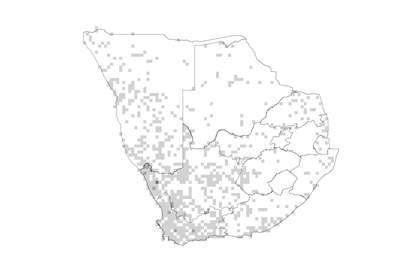 Species distribution and density. Darker squares represent higher density of members of this family. |
Introduction
(excluding Mesembryanthemaceae)
Kraalbos family
This is a relative small family found mainly along the coastal areas of the tropics. About half of all species in the family belong to the genus Tetragonia.
Distribution
Grows in the tropics and subtropics extending into dry, warm, temperate Africa, Asia and North America with a centre of diversity in Africa. In southern Africa the highest diversity is along the West Coast from the Western Cape through Namaqualand to southern Namibia.
Number of genera in the world
ca. 12
Number of species in the world
ca. 174
Number of genera in the Flora of southern Africa region
10
Number of species in the Flora of southern Africa region
106
Well-known southern African genera
Aizoon, Galenia, Sesuvium, Tetragonia, Trianthema
Growth forms
Annual herbs to perennial, woody shrubs, mostly somewhat succulent.
Habitats
Mostly in sandy coastal vegetation and dry to arid inland plains.
Flagship species
Tetragonia decumbens (dune spinach; duinespinasie [A]) is a spreading shrub with dark green, somewhat succulent leaves, small yellow flowers and thick 4-winged fruit. This species is ecologically important in stabilising coastal dunes and is widely used for rehabilitation of coastal areas. Young growth is washed, cooked and eaten as spinach. Through appropriate selection it has potential to develop into an economical crop similar to the New Zealand spinach, *T. tetragonioides. (Photo: JF).
Significance of the family
Tetragonia tetragonioides has limited use as a leaf vegetable but is a noxious invasive weed in many areas of the world. Some species are used in ecological rehabilitation for binding sand dunes in coastal regions.
Diagnostic characters
Leaves alternate, opposite or in whorls with or without stipules. Flowers small, regular; corolla much reduced or absent. Anthers 4 to numerous, usually free. Calyx persistent, with 4 or 5 lobes. Styles usually 2 or more, free. Ovary inferior or superior. Fruit a capsule.
Did you know?
Galenia africana, a pioneer from Namaqualand, is often not only the first perennial to establish in disturbed veld, but frequently the last to survive in overgrazed situations.